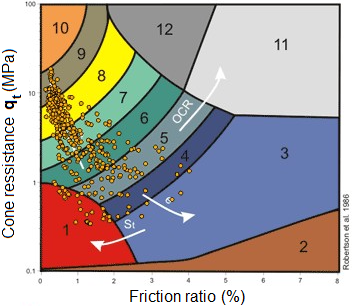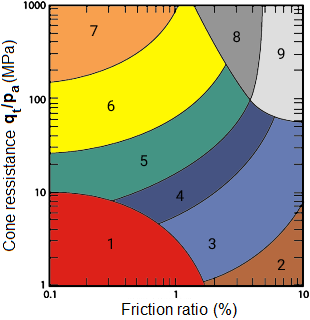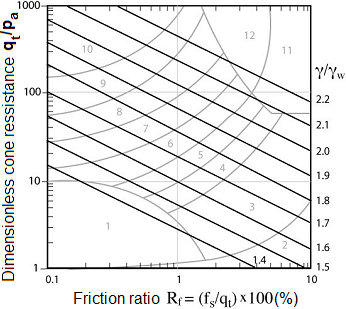Classification of Soils According to Robertson
During the classification of soils according to Robertson (1986 or 2010) it is not necessary to input parameters of soils, the program performs this step automatically with their assignment to the geological profile. For this reason, the assessment of the performed CPT is very fast and especially clear.
Classification of soils according to Robertson (1986 or 2010) is based on the measured values of penetration resistance qc, local skin friction fs, pore pressure u2 respectively. Based on the corrected value of the cone resistance qt = qc + u2 * (1 - a), or percentage ratio qc /pa and friction ratio Rf = fs /qt program automatically performs the assignment of soil behavior type (SBT) according to the following graphs. pa - atmospheric pressure = 100 kPa (= 1 tsf).
 Non-normalized CPT Soil Behavior Type (SBT) chart according to Robertson, 1986 (source: Robertson et al., 1986)
Non-normalized CPT Soil Behavior Type (SBT) chart according to Robertson, 1986 (source: Robertson et al., 1986)
Soil classification according to Robertson, 1986 (source: Robertson et al., 1986)
Zone | Soil Behavior Type (SBT) |
1 | Sensitive fine-grained |
2 | Organic material |
3 | Clay |
4 | Silty Clay to clay |
5 | Clayey silt to silty clay |
6 | Sandy silt to clayey silt |
7 | Silty sand to sandy silt |
8 | Sand to silty sand |
9 | Sand |
10 | Gravelly sand to sand |
11 | Very stiff fine-grained * |
12 | Sand to clayey sand * |
* Overconsolidated or cemented soil
 Non-normalized CPT Soil Behavior Type (SBT) chart according to Robertson, 2010 (source: [4], Figure 21, pp. 26)
Non-normalized CPT Soil Behavior Type (SBT) chart according to Robertson, 2010 (source: [4], Figure 21, pp. 26)
Soil classification according to Robertson, 2010 (source: [6], Figure 21, pp. 26)
Zone | Soil Behavior Type (SBT) |
1 | Sensitive, fine-grained |
2 | Organic soils - clay |
3 | Clay - silty clay to clay |
4 | Silt mixtures - clayey silt to silty clay |
5 | Sand mixtures - silty sand to sandy silt |
6 | Sands - clean sand to silty sand |
7 | Gravelly sand to dense sand |
8 | Very stiff sand to clayey sand * |
9 | Very stiff fine-grained * |
* Heavily overconsolidated or cemented
A newer classification of soils according to Robertson (2010) contains a smaller number of individual classes of soils than the original soil classification from 1986. However, the classification of soils according to Robertson (2010) is now more accurate and more used in the world.
If it's chosen option "calculate" for unit weight of soil in the frame "Soil Classification", then the unit weight of soil γ is determined by the following formula:
![]()
where: | γw | - | unit weight of water (≈10) [kN/m3] |
pa | - | atmospheric pressure (≈100) [kPa] |
![]()
where: | Rf | - | friction ratio between skin friction and cone resistance |
 Dimensionless soil unit weight γ/γw based on CPTs (source: [4], Figure 28, pp. 36)
Dimensionless soil unit weight γ/γw based on CPTs (source: [4], Figure 28, pp. 36)
The input of the thickness of soil layers influences what is the minimum thickness of the layer of the ith soil. In case of the zero layers of soil there are assigned all layers of soils based on the soil classification according to Robertson (1986 or 2010) into the geological profile.
When the input is a non-zero minimum thickness of layer, then the number of layers of soil is reduced in the geological profile. The layout and number of the soil layer, affect the vertical bearing capacity and settlement of pile or spread footing investigated by CPT.
Literature:
[1] EN ISO 22476-1: Geotechnical investigation and testing - Field testing. Part 1: Electrical cone and piezocone penetration test, 2013.
[2] EN ISO 22476-12: Geotechnical investigation and testing - Field testing. Part 12: Mechanical cone penetration test (CPTM), 2009.
[3] Robertson, P. K.: Interpretation of Cone Penetration Tests – a unified approach. Canadian Geotechnical Journal, 2009, No. 46, pp. 1337 – 1355.
[4] Robertson, P. K. and Cabal, K. L.: Guide to Cone Penetration Testing for Geotechnical Engineering. Gregg Drilling & Testing, Inc., USA, 6th edition, 2014, 133 p.